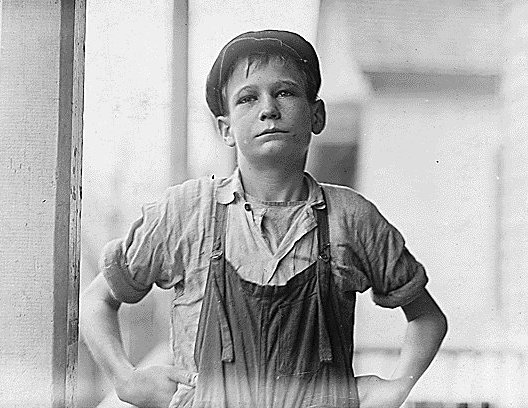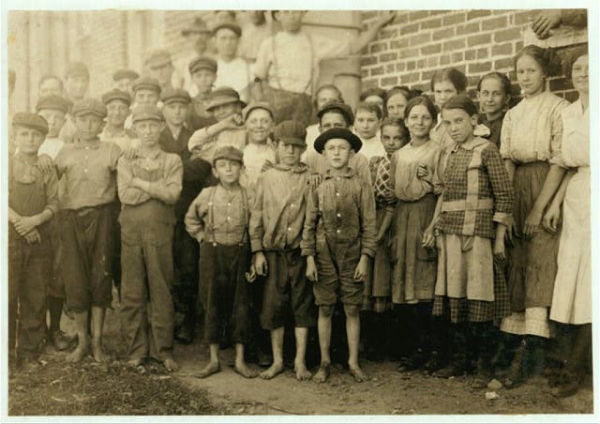
"In U.S. South, Textile Mills Gone but Not Forgotten," by Willie Drye in National Geographic News, on 19 October 2004: For more than a century after the U.S. Civil War ended in 1865, the working day began across the South with the shriek of whistles at textile mills.
The whistles have nearly stopped blowing, however. The jobs that once underpinned the economy of hundreds of small towns from Virginia to Mississippi are now in Mexico, India, and China. The handsome old redbrick buildings where people once earned the money to raise families are empty, and many are falling into disrepair.

Today some people question whether younger generations understand how hard their parents and grandparents worked to make ends meet and build their communities.
Now a determined group of former mill workers, professional and amateur historians, and volunteers has launched a grassroots effort to preserve at least some of what remains of a vanishing era.
"We're trying to create a big, giant vacuum cleaner to capture those memories, or the stories will be gone," said Lynn Rumley, the great-granddaughter of a Virginia textile worker. Rumley lives in the former mill town of Cooleemee, North Carolina—about 26 miles (42 kilometers) southwest of Winston-Salem—and is leading the Southwide Textile Heritage Initiative.
Rumley wants to raise money and recruit members to compile oral histories of textile workers, to persuade school systems to teach students about their textile heritage, and to lure tourists to the old mill villages.
"We really do believe that this is a story people want to hear about," Rumley said. "It's a way of life that's gone, by and large."

Cotton spinning mill with children at work, South Carolina, 1903.
It was a compact lifestyle so nearly identical throughout the South that, if you asked mill hands in the rolling hills of northern Georgia or the coastal plain of North Carolina where they lived, they'd probably say, with a mixture of pride and self-effacement, "I live on the mill hill."
In small towns such as Haw River, North Carolina, and Valley, Alabama, and larger cities such as Macon, Georgia, and Columbia, South Carolina, hundreds of thousands of men and women went into the mills every morning. They ran the spindles and looms, loaded and unloaded the trucks, kept the books, and signed the paychecks.
At the end of their shifts they went home to mill-owned housing that they rented for a few dollars a month. When they went shopping they bought groceries and supplies in mill-owned stores. They watched movies in theaters built by the mill, and they played baseball for mill-sponsored teams.

They also developed deep personal bonds. They looked after their neighbors' children when parents had to work. And when there was a death or illness, they cleaned their neighbors' houses, cooked their meals, and comforted the bereaved families.
"It instilled a sense of togetherness, fellowship, whatever you want to call it," said Joel Jackson, who grew up in Bemis, Tennessee, a mill town about 80 miles (130 kilometers) east of Memphis. "It was a tight-knit community. I knew 90 percent of the people in town as a kid, and my dad knew everybody. If anybody got in trouble, or there was a death, everybody was there to help until they were not needed."
The mill life also had its idyllic aspects. "We were on the low end of the economic ladder, but we didn't lack for anything," Jackson said. "It was a simple life, but it was satisfying." ...

But there was a darker side to the South's textiles industry.
The region's dependence on textiles began after the Civil War, when many towns desperate for industry scraped together their own capital to start cotton mills. Impoverished mountaineers and farmers left their land to work in those mills. Textile barons in New England, eager to take advantage of a large pool of cheap labor, also started moving their operations south.
North Carolina journalist Gerald W. Johnson said profit "never became the dominant motif" for many of these early mills. "Always it was the prospect of civic and social salvation that was stressed," Johnson said.

But with people willing to work for very low wages, most of the mills made money anyway. Profits started booming in 1914, when World War I began and Southern textile mills landed huge military contracts.
But things changed when the war ended and windfall profits stopped. Many mills were now in the hands of owners who weren't motivated by "social salvation." By the late 1920s their greed and mismanagement had brought hard times to the textile towns. Many mill hands lost their jobs, and those who continued to work faced ever increasing production demands.

Flaring tempers and violence took a deadly turn in March 1929, when textile workers fed up with pay cuts and ceaseless demands for more production went on strike in Gastonia, North Carolina. A sheriff and several mill workers were shot dead.
Mill owners often used brutal tactics to break textile strikes, and organized labor was never able to gain much of a foothold in the South.
By the end of World War II in 1945, the industry had stabilized again, and textile towns flourished for about 25 years. No one knows exactly how many people worked in the southern mills when they were at their peak employment. But in 1960 there were 505,000 textile workers in North Carolina alone.

This photograph depicts the fire at the textile mill in Avalon, N.C. on June 11, 1911. I had never heard of Avalon and so turned to the handy North Carolina Gazetteer to figure out exactly where it is. Or, in this case, was. The story of Avalon gives us a sense of just how important the local mill was to early 20th-century North Carolinians. The fire was a disaster, damaging the mill well beyond any point where it could have been repaired. With the primary engine of their economy gone, the people of Avalon, located in Rockingham County, loaded around sixty houses, a Moravian church, a school, and a company store onto horse-drawn rollers and moved the whole town two miles west to Mayodan. (source: North Carolina Miscellany)
The textile industry has never lost its appetite for cheap labor, and the jobs that once filled the southern mills started to be shipped outside the United States.
Norris Dearmon, who spent 43 years in the office of Cannon Mills in Kannapolis, North Carolina, recalls the days when 18,000 people worked in the giant plant there. But after changing owners and shedding jobs for more than a decade, that mill closed in July 2003. "All the equipment's been stripped out and sent to China, India, Mexico, wherever," Dearmon said. "They really cleaned it out."
Now Dearmon is helping with the textile heritage preservation effort. Among other things, he's collecting reed hooks that weavers used in the mills. When a thread broke on their looms, weavers used reed hooks to snag the strands so the threads could be tied back together. The hooks often became very personal tools, because many weavers made their own.

Tom Hanchett, historian at the Levine Museum of the New South in Charlotte, said he hopes the work of Rumley, Dearmon, Jackson, and others will spur other people to restore the unused mill buildings. He'd like to see them used for other purposes and suggests that a textile heritage trail across the South be created to recount the times when the lives of generations of Southerners revolved around the old mill villages.
"It's always important to know where we came from," Hanchett said. "It's important to celebrate the hard work and vision that created the world we're in now, to realize that it didn't just happen [on its own]."
Willie Drye is the author of Storm of the Century: The Labor Day Hurricane of 1935, published by National Geographic.

I feel this is among the most vital information for me.
ReplyDeleteAnd i am happy reading your article. However want to commentary on few common issues, The web site taste is
ideal, the articles is actually excellent : D. Just right task,
cheers
Here is my site ; soul radio
I don't drop many responses, but i did some searching and wound up here "Southern Textile Mills". And I actually do have a couple of questions for you if it's allright.
ReplyDeleteIs it only me or does it seem like some of the remarks come across like they are coming from brain dead visitors?
:-P And, if you are writing at additional online sites, I'd like to keep up with anything new you have to post. Would you make a list of all of your communal pages like your linkedin profile, Facebook page or twitter feed?
Feel free to surf to my blog - mehlallergie symptome
Hey! Do you know if they make any plugins to protect against hackers?
ReplyDeleteI'm kinda paranoid about losing everything I've worked hard on.
Any recommendations?
Here is my web page: Finanzberater Mainz
discovered your weblog website internet website on the internet and appearance some of your early posts. Continue to keep in the excellent operate. I just now additional increase your Rss to my MSN News Reader. Seeking toward reading far far more from you locating out at a later date!bursting strength tester
ReplyDeleteI want to share a testimony on how Le_Meridian funding service helped me with loan of 2,000,000.00 USD to finance my marijuana farm project , I'm very grateful and i promised to share this legit funding company to anyone looking for way to expand his or her business project.the company is funding company. Anyone seeking for finance support should contact them on lfdsloans@outlook.com Or lfdsloans@lemeridianfds.com Mr Benjamin is also on whatsapp 1-989-394-3740 to make things easy for any applicant.
ReplyDeleteHello everyone on here my name is Fumo Sadiku living in Malindi City Kenyan I want to tell a little more about a good hearten man called Benjamin Breil Lee working with funding service as loan officer, Mr Benjamin Breil Lee helped me get a loan of 37,115,225.00 Shillings on my trying time trying to get back on my feet to raise my business I know there are some of you here who are in financial difficulties to talk to Mr Benjamin on what's app +1-989-394-3740 Or also with his personal E-mail on lfdsloans@outlook.com I'm so glad for what he did for me and for his Bank accountant as well Accountant Hernandez Lucas Thank you very much for your work well done.
ReplyDelete